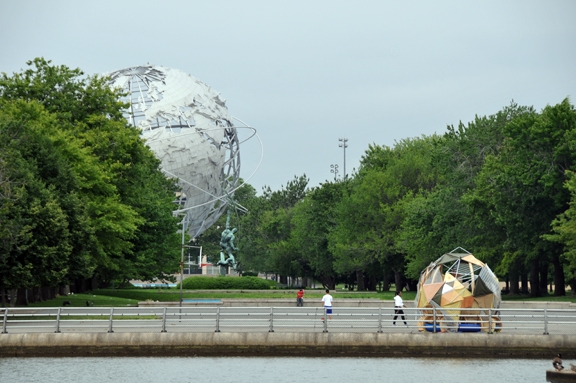
The New York City Department of Parks & Recreation is pleased to announce the installation of a series of mobile temporary artworks, by artist Mary Mattingly. Part of her larger Flock House Project, four new Houses will travel to multiple locations within the borders of the five boroughs. On view through September, The Flock House Project can be seen on parkland multiple times this summer- beginning with the arrival of structures at Flushing Meadows, Corona Park and Battery Park, and eventually traveling to Snug Harbor, Coleman Oval, and Van Cortlandt Park.
Part fantastic and part practical living, The Flock House Project is a group of self-contained ecosystems whose design was inspired by patterns of global human migration, immigration, and pilgrimage. These mobile living systems, which are inhabited by artists, promote and implement a wider adaptation of “green” technologies—including hands-on opportunities to learn about rainwater capture, inner city agriculture, solar energy technologies, and scalable, transportable living spaces. In a time when urban populations are faced with environmental, political, and economic instability, dislocation and relocation become important to consider and reconcile. Addressing these themes and concerns, Mattingly sees Flock Houses choreographed throughout urban centers in the United States on three planes of living - subterranean, ground, and sky.
Initiated in DUMBO, Brooklyn in 2010 at Smackmelon, The Flock House Project seeks to enhance community-interdependence, resourcefulness, learning, curiosity, and creative exploration through its physical presence, its artist inhabitants, and an abundance of interactive community programs. Workshops, lectures, performances, an interactive website, and narrated cell phone tours focusing on the area’s history, current surroundings, and future opportunities have all been scheduled for the project. Engaging in an interesting dialogue with New York City’s history of community and innovation, The Flock House Project leaves visitors pondering the future and further technological advancement. For more information about the project and programming schedule, visit www.FlockHouse.org.
Mary Mattingly, whose work merges performance, sculpture, architecture, and documentation, addresses issues of home, migration and living systems. Her noted The Waterpod Project in 2009 was, a floating, sculptural living system and public space in New York City drew in over 200,000 visitors. Mattingly’s work has been featured in a number of esteemed publications including the New York Times, the New Yorker, The London Times, Aperture, and her work has been shown nationally and internationally.
Additional supporters include Architecture Omi, The Battery Park Conservancy, Black Umbrella, Eyebeam Center for Art and Technology, Harpo Foundation, Jerome Foundation,
Lower Manhattan Cultural Council, Marie Walsh Sharpe Foundation, New York City Mayor's Office of Special Projects, New York Foundation for the Arts, Slippery Slope Farm, The Clocktower Gallery & Radio ARTonAIR.org, The Richard J. Massey Foundation for Arts and Sciences, The River to River Festival, Skybridge Capital, and Time Equities, Inc.
The City of New York’s Department of Parks & Recreation Art in the Parks program has consistently fostered the creation and installation of temporary public art in parks throughout the five boroughs. Since 1967, collaborations with arts organizations and artists have produced hundreds of public art projects in New York City parks.